Regulation and localization of the Bloom syndrome protein in response to DNA damage
- PMID: 11309417
- PMCID: PMC2169463
- DOI: 10.1083/jcb.153.2.367
Regulation and localization of the Bloom syndrome protein in response to DNA damage
Abstract
Bloom syndrome (BS) is an autosomal recessive disorder characterized by a high incidence of cancer and genomic instability. BLM, the protein defective in BS, is a RecQ-like helicase, presumed to function in DNA replication, recombination, or repair. BLM localizes to promyelocytic leukemia protein (PML) nuclear bodies and is expressed during late S and G2. We show, in normal human cells, that the recombination/repair proteins hRAD51 and replication protein (RP)-A assembled with BLM into a fraction of PML bodies during late S/G2. Biochemical experiments suggested that BLM resides in a nuclear matrix-bound complex in which association with hRAD51 may be direct. DNA-damaging agents that cause double strand breaks and a G2 delay induced BLM by a p53- and ataxia-telangiectasia mutated independent mechanism. This induction depended on the G2 delay, because it failed to occur when G2 was prevented or bypassed. It coincided with the appearance of foci containing BLM, PML, hRAD51 and RP-A, which resembled ionizing radiation-induced foci. After radiation, foci containing BLM and PML formed at sites of single-stranded DNA and presumptive repair in normal cells, but not in cells with defective PML. Our findings suggest that BLM is part of a dynamic nuclear matrix-based complex that requires PML and functions during G2 in undamaged cells and recombinational repair after DNA damage.
Figures
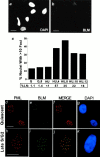

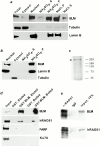


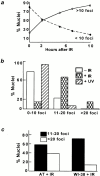
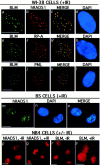
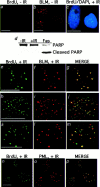
References
-
- Aurias A., Antoine J.L., Assathiany R., Odievre M., Dutrillaux B. Radiation sensitivity of Bloom's syndrome lymphocytes during S and G2 phases. Cancer Genet. Cytogenet. 1985;16:131–136. - PubMed
-
- Banin S., Moyal L., Shieh S., Taya Y., Anderson C.W., Chessa L., Smorodinsky N.I., Prives C., Reiss Y., Shiloh Y., Ziv Y. Enhanced phosphorylation of p53 by ATM in response to DNA damage. Science. 1998;281:1674–1677. - PubMed
-
- Beamish H., Khanna K.K., Lavin M.F. Ionizing radiation and cell cycle progression in ataxia telangiectasia. Radiat. Res. 1994;138:130–133. - PubMed
-
- Brosh R.M., Li J.L., Kenny M.K., Karow J.K., Cooper M.P., Kureekattil R.P., Hickson I.D., Bohr V.A. Replication protein A physically interacts with the Bloom's syndrome protein and stimulates its helicase activity. J. Biol. Chem. 2000;275:23500–23508. - PubMed
Publication types
MeSH terms
Substances
Grants and funding
LinkOut - more resources
Full Text Sources
Molecular Biology Databases
Research Materials
Miscellaneous

